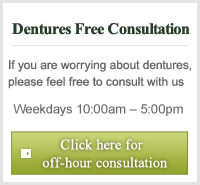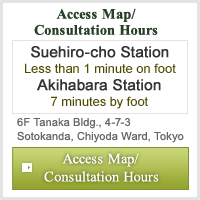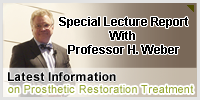2009年3月29日 - 2009年4月 4日 « トップへ » 2009年4月12日 - 2009年4月18日
2009年4月11日
Cases of TMJ arthrosis caused by dentures
A patient who came in complaining of pain in the right jaw and the inability to open his mouth straight.
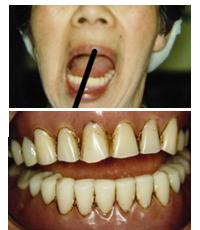 [state of the mouth when opened]
[state of the mouth when opened]
Seen from the front, it is obvious that the jaw has shifted to the left.
[state of dentures]
Looking at the dentures, it can be seen that the teeth on the left side are more worn down than those on the right side.

We took an X-ray of the joints in the jaw. We were able to diagnose that the articular disk on the left-hand side was shifted forward and had lost function.


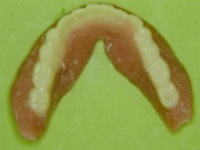 Since this treatment method was to be carried out before making new dentures, we duplicated the patient's dentures, lowered the front of the lower jaw and raised the right side of her bite by 2 millimeters to give her smooth movement. We confirmed that she was able to open her mouth straight using the duplicate dentures and after making sure there was no more pain in the jaw, we remade her dentures.
Since this treatment method was to be carried out before making new dentures, we duplicated the patient's dentures, lowered the front of the lower jaw and raised the right side of her bite by 2 millimeters to give her smooth movement. We confirmed that she was able to open her mouth straight using the duplicate dentures and after making sure there was no more pain in the jaw, we remade her dentures.

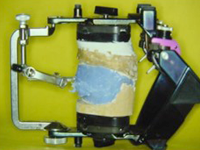 We take a mold of Inaba-style full dentures using the maxillomandibular simultaneous impression method.
We take a mold of Inaba-style full dentures using the maxillomandibular simultaneous impression method.
What are full dentures made using the maxillomandibular simultaneous impression method?

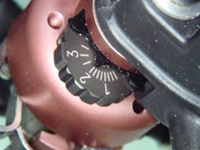 We used the PDRI Insert of the KaVo PROTAR actuator, a device used to measure bite alignment, to adjust the patient's bite alignment by lowering the front of the lower jaw in order to provide her with smooth jaw movement.
We used the PDRI Insert of the KaVo PROTAR actuator, a device used to measure bite alignment, to adjust the patient's bite alignment by lowering the front of the lower jaw in order to provide her with smooth jaw movement.

Dentures were made after we confirmed that the right jaw needed to be lowered by 2 millimeters during the jaw function exam by creating a graph using CADIACS and setting the PDR insert to 0 and then again to 2 millimeters.

We were able to alleviate the patients jaw pain with these dentures and they also allowed her to open her mouth straight.

This treatment method produces dentures that allow movement of the jaw joints. This particular case was rather complicated and required Dr. Shigeru Inaba's wide range of knowledge. It is very likely that using dentures that do not fit correctly over a long period of time may lead to TMJ arthrosis.
2009年4月10日
Full dentures made using the maxillomandibular simultaneous impression method
Upper and lower full dentures (base price) .... 3,240,000 yen
(4 to 5 visits to the clinic are necessary)
For 3 days of consecutive treatment .... 5,400,000 yen
(This plan requires the dentist and technician to allot three full days to only one patient)

The process of treating TMJ arthrosis (an actual case)
During the initial exam we found that the patient could not open her mouth and that she experienced pain when she tried to do so. Her right jaw made a snapping noise. She shared with us that she was constantly worried about the area in front of her right ear and that it was effecting her work.
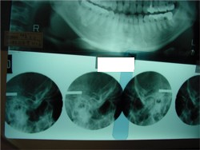 At first glance, it seemed that there were no obvious problems with the inside of her mouth. To the right is an X-ray image of the inside of her mouth. The many crowns and fillings in her molars stand out, but there was no problem with the shape of her jaw.
At first glance, it seemed that there were no obvious problems with the inside of her mouth. To the right is an X-ray image of the inside of her mouth. The many crowns and fillings in her molars stand out, but there was no problem with the shape of her jaw.

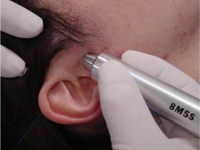 We examined the joints of her jaw using a Doppler stethoscope. We listened to find out whether the snapping noise occurred when she opened her jaw or when she closed it. In this patient's case, a snapping sound occurred in the joints on the right side when she opened her jaw. She was also unable to open her jaw straight.
We examined the joints of her jaw using a Doppler stethoscope. We listened to find out whether the snapping noise occurred when she opened her jaw or when she closed it. In this patient's case, a snapping sound occurred in the joints on the right side when she opened her jaw. She was also unable to open her jaw straight.


The second time she came to the clinic we took a mold and examined it. This is after we added plaster to the mold of her upper and lower jaw and neatly trimmed it.

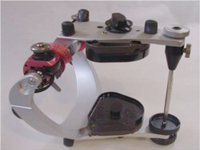 We then attached the mold to a device called an actuator, which can accurately reproduce jaw movements. The angle of jaw movement is different in each person. The jaw movement is always quite complex when people grind their teeth. The jaw rotates and moves back and forth and to the left and right. It is necessary in TMJ arthrosis patients to undergo this detailed examination.
We then attached the mold to a device called an actuator, which can accurately reproduce jaw movements. The angle of jaw movement is different in each person. The jaw movement is always quite complex when people grind their teeth. The jaw rotates and moves back and forth and to the left and right. It is necessary in TMJ arthrosis patients to undergo this detailed examination.

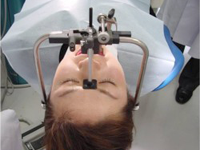 This is a face-bow transfer. It is a device used to attach the upper jaw mold to the actuator. We can use it to examine whether or not the bite alignment plane is vertically aligned with the midpoint of the body. It is important to use the face-bow transfer even when making just a single crown or filling.
This is a face-bow transfer. It is a device used to attach the upper jaw mold to the actuator. We can use it to examine whether or not the bite alignment plane is vertically aligned with the midpoint of the body. It is important to use the face-bow transfer even when making just a single crown or filling.

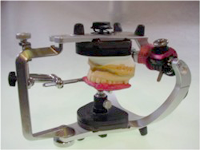 This is how we transfer the recorded data to the actuator. The relationship between the midpoint of the body (midpoint of the actuator) and the bite alignment is transferred accurately.
This is how we transfer the recorded data to the actuator. The relationship between the midpoint of the body (midpoint of the actuator) and the bite alignment is transferred accurately.

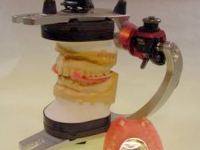 It is not enough that the upper and lower bite alignment meet at only a particular location when biting. We record the central position (the original position where the jaw is most relaxed) and then attach the upper and lower teeth.
It is not enough that the upper and lower bite alignment meet at only a particular location when biting. We record the central position (the original position where the jaw is most relaxed) and then attach the upper and lower teeth.

Then we check to see if there are any changes between the position of the jaw when relaxed and the position when biting. In this patient's case, the reconstructed (fixed) fillings and crowns turned out to be the cause of her symptoms. This mold examination is extremely important and teaches us a lot about the condition. A high level of skill is required to master this examination technique.(IPSG)


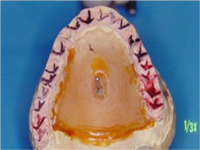 There are many grooves hidden inside of the shape of teeth. These are not random imperfections, but they actually follow rules.
There are many grooves hidden inside of the shape of teeth. These are not random imperfections, but they actually follow rules.

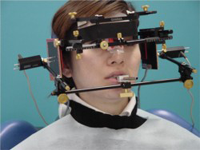 The third time the patient visited the clinic we record the movements of her jaw in 3-D and examined her jaw function. We record how her jaw movement has changed after treatment compared to before treatment.
The third time the patient visited the clinic we record the movements of her jaw in 3-D and examined her jaw function. We record how her jaw movement has changed after treatment compared to before treatment.

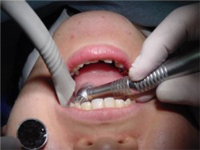 It varies per case, but usually during the fourth visit we administer sprint therapy or instruct the patient on how to perform home therapy. In this patient's case, since the cause of her symptoms was unbalanced bite alignment due to fillings and crowns, we carried out occlusal adjustment.
It varies per case, but usually during the fourth visit we administer sprint therapy or instruct the patient on how to perform home therapy. In this patient's case, since the cause of her symptoms was unbalanced bite alignment due to fillings and crowns, we carried out occlusal adjustment.
Occlusal adjustment needs to be monitored and is usually complete after being carried out 1 to 3 times.

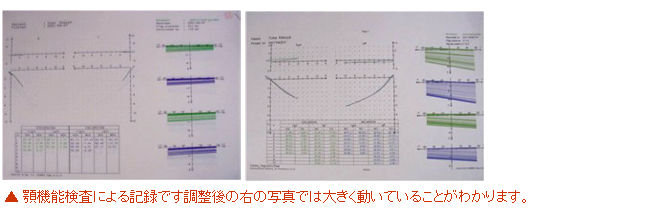
After adjustment, the patient was cured of the snapping noise in her right jaw joints. She also regained the ability to open her mouth straight. You can see from the image to the left that her jaw was barely moving at all. The image to the right shows that she was able to move and open her jaw widely after adjustment.
The patient was very pleased. She told us that she initially thought the pain was a result of being tired from work, but after treatment she was able to happily return to work in good health.
*TMJ arthrosis treatment is not covered by national health insurance and we charge 10,000 yen (tax not included) for the first examination.
2009年4月 9日
Dental medical expense deductions?
Medical expense deductions refer to a certain amount of tax deduction you may receive in case you have paid medical expenses for you or someone in your family.
Costs related to denture treatment are eligible for medical expense deductions. Medical expense deductions are part of a system put into place to reduce the financial burden of medical costs. If you must spend more than 100,000 yen in one year on medical costs, then a portion of your income tax will be returned to you.
In the case that medical expenses are incurred by a person or a spouse or other family members supported by that person (between January 1 and December 31 of each year), and these expenses are reported by March 15 of the next year, then that person can receive back a portion of their tax as a medical expense deduction or their tax burden will be lightened.
However, if medical expenses do not exceed 99,999 yen in one year, then no deductions can be made (the amount reported cannot exceed 2,000,000 yen).
People whose gross income does not exceed 2,000,000 yen can report medical expenses that equal or exceed 5% of their income.
Medical costs that can be written off as medical expense deductions
- Examination and treatment costs paid to a doctor or a dentist
- Cost of pharmaceuticals used for treatment
- Transportation costs associated with travelling to and being admitted to the hospital (train fares, bus fares, taxi fares etc.)
- Costs of masseuses, acupuncturists, and moxibutionists for treatment
- Others
Requisites to receive a return of funds
- Tax return (income earner's withholding slip)
- Receipt (must be original, no copies)
- Official stamp (inkan) and bank/etc. passbook
*Your tax return can be retrieved at your local tax office.
*The declaration period is between February 16 and March 15 of the following year. However, salaried employees can receive their returns from January of that year.
If you paid for treatment with a dental loan
A dental loan is when a patient has a credit company front the money for dental treatment and must pay back the amount in installments. In this case, the patient is eligible for medical expense deductions the same year that the credit company fronted the amount.
Moreover, In the case of dental loans, it is possible that the patient will not be in possession of the receipt. If this is the case, a copy of the contract with the credit company can be used.
*Please be informed that interest and processing fees are not eligible for medical expense deductions.
2009年4月 7日
We aim to provide a stress free dental clinic.
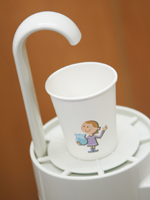 This is a stress free dental clinic. The dental clinic is a place patients are never really excited about visiting. Many people come for the following reasons:
This is a stress free dental clinic. The dental clinic is a place patients are never really excited about visiting. Many people come for the following reasons:
+ "I lost a filling"
+ "I am in pain"
We take every measure to make sure that patients who visit our clinic receive treatment without feeling stressed.
For example, it is often the case that patients coming in for their first exam tend to feel anxious. We are well aware of this and do all that we can to help patients relax. We have chosen an at-home interior decorating style and we strive for a soothing and warm atmosphere in which are patients can feel at ease.
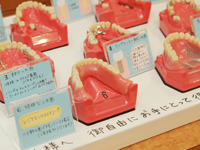 Anyone suffering from disease is bound to feel stress. Even during such uncomfortable times, kind treatment can ease some of the stress.
Anyone suffering from disease is bound to feel stress. Even during such uncomfortable times, kind treatment can ease some of the stress.
It is our primary goal to build a warm and trusting relationship with our patients. Therefore we endeavor every day to maintain a stress free clinic.
A dental practice that doesn't really feel like a dental clinic
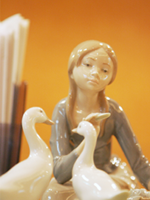 A dental practice that doesn't really feel like a dental clinic
A dental practice that doesn't really feel like a dental clinic
Since our clinic is located on the 6th floor of a small building in the Akihabara electronics district, our location doesn't really stand out. You may not believe that there is a dental clinic inside of this small building when you first see it from the outside. We have just one small billboard outside.
When patients take the elevator up to the 6th floor, they may not think that they have arrived at a dental clinic (our clinic is specifically designed not to look like a run-of-the-mill dental clinic).
We do not keep our patients waiting
Simply waiting in a waiting room can be a stressful experience so consultations and examinations at our clinic are by appointment only.
There is nothing pleasant about being made to wait for other patients coming and going. Not to mention, it is an added source of stress for our staff who cannot break concentration while providing treatment.
Rather than actually 'waiting' in the waiting room, patients usually tend to just worry about whether or not the day's treatment will hurt. Wouldn't it be nice to use that time thinking about more pleasant things?
Feel free to enter our clinic in your outdoor shoes.
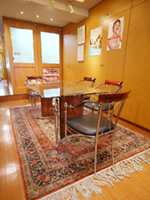 We would also have you enter our waiting room and examination room in your own shoes. Our staff cleans every day and the floors are waxed once a month.
We would also have you enter our waiting room and examination room in your own shoes. Our staff cleans every day and the floors are waxed once a month.
Changing into slippers worn by multiple strangers can also cause patients stress. Almost all restaurants and high-end hotels allow you to wear your own shoes these days. So please feel free to enter our clinic as you are.
2009年4月 6日
When my patients are happy, I am so happy that I skip home.
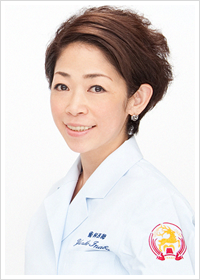 Currently I have a husband and 2 daughters. We are a family of 4. I love taking trips. When I was single I used to take trips by myself to Europe. Now I dream about travelling the world and visiting wonderful places with my family.
Currently I have a husband and 2 daughters. We are a family of 4. I love taking trips. When I was single I used to take trips by myself to Europe. Now I dream about travelling the world and visiting wonderful places with my family.
The source of my happiness is the wonderful smiles of satisfied patients.
The source of my happiness is my family and friends, and making my patients happy as a dentist. No matter how many times I see the spectacular smiles (and teeth) of my patients, I am always overjoyed. Those days fill me with so much pride and happiness that I just want to skip home from work!
Do you avoid going to the dentist because you are afraid that it is going to hurt?
At our clinic we provide tooth treatment and especially denture treatment that aims to bring happiness back to the lifestyles of our patients who have lost teeth. If you are worried about full dentures or partial dentures, or if you have had to have dentures remade time and time again because they don't fit correctly, please leave it to Inaba Dental Office.
We make dentures that will leave you wondering if you even have them in your mouth since chewing any type of delicious food will be easy and people will not notice them. Our staff works together all day to ensure that our patients can achieve a spectacular smile.
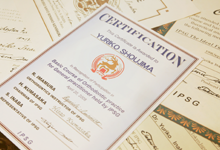 [Brief Background]
[Brief Background]
1997Graduated, Nippon Dental University, Received Dentist License1997Resident, Nippon Dental University1998Resident (1 year), Anesthesiology Department, Toho University Ohashi University Hospital1999Inaba Dental Office opens (current post)*Received various training in Germany and Switzerland
[Affiliations]
Japan Academy of Esthetle Dentistry
Member, ISOI International Society of Oral Implantology
Certified Dentist, Academy of Clinical Dentistry
General Affairs, IPSG
Member, Germany Chamber of Commerce
2009年4月 5日
Advisor Shigeru Inaba, a pioneer in Riegel Telescope
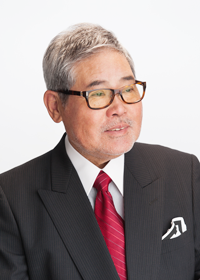 He introduced the highly advanced Riegel Telescope method into Japan and has since used it to treat more than 1000 cases.
He introduced the highly advanced Riegel Telescope method into Japan and has since used it to treat more than 1000 cases.
At a meeting of the Academy of Clinical Dentistry held from June 20 to June 21 of this year, he introduced a production method for full dentures using the maxillomandibular simultaneous impression method for difficult cases.
On top of serving as the top advisor for IPSG, he continues to provide and research the best dental treatments.
[Brief Background]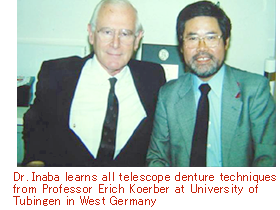
1964Graduated, Nippon Dental University1968Graduated, Nippon Dental University Graduate School1969Lecturer, Prosthetics Class, School of Dentistry, Nippon Dental University1972Assistant Professor, Prosthetics Class, School of Dentistry, Nippon Dental University1978Exchange Student, University of Tubingen, West Germany, Visiting Professor under Professor E. Koerber1992Professor, Department of Gerodontology, School of Dentistry, Nippon Dental University19993rd Lecture Professor, Prosthetics Class, School of Dentistry, Nippon Dental UniversityCurrent IPSG (Interdisciplinary Practical Study Group) Comprehensive Dental Treatment Research Group Representative
[Affiliations]
- Standing Director, Japanese Society of Gerodontology
- Trustee, Japan Geriatrics Society
- Trustee, Japanese Society for the Study of Chronic Pain
- Trustee, Japanese Society of Dental Practice Administration
- Trustee, (Corp.) Japan Oral Health Association
- Trustee, (Corp.) Oral Health Association
- Trustee, Japanese Association for Toothfriendly Sweets
- Top Advisor, IPSG (Interdisciplinary Practical Study Group)
- President, Japanese Society of General Oral Medicine
[Reliable technology learned from famous overseas doctors]
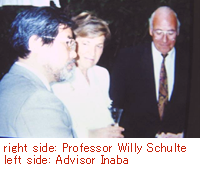 Professor Willy Schulte was teaching about TMJ arthrosis at the University of Tubingen when I travelled there as an exchange student to study the topic. It was meeting this gifted professor that inspired me to make the study of TMJ arthrosis the theme of my life.
Professor Willy Schulte was teaching about TMJ arthrosis at the University of Tubingen when I travelled there as an exchange student to study the topic. It was meeting this gifted professor that inspired me to make the study of TMJ arthrosis the theme of my life.
I also learned the muscle palpation diagnostic method from Professor Kropol in the field of TMJ arthrosis. I also received actual instruction on bite alignment from Professor Jankleson, Professor Lauritzen, and Professor Eichner.
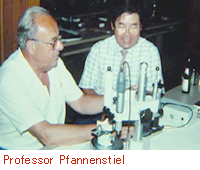 Dental technician, Professor Pfannenstiel taught me the milling technique for Konus telescope.
Dental technician, Professor Pfannenstiel taught me the milling technique for Konus telescope.
Professor Charles E. Stewart is a famous American who is famous for being the father of nanology. I am greatly influenced by his lessons on the fundamentals of nanology including jaw movements and tooth shape.

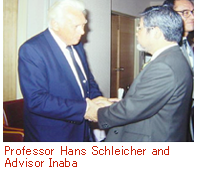 Also, when Professor Hans Schleicher retired, he left all of his resources concerning full dentures to Advisor Inaba. Many other great dentists have contributed to the clinical practice of Advisor Inaba.
Also, when Professor Hans Schleicher retired, he left all of his resources concerning full dentures to Advisor Inaba. Many other great dentists have contributed to the clinical practice of Advisor Inaba.
Introduction of Dr. Tomohiro Inaba (Yamabukicho Clinic)
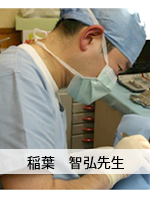 [Brief Background]
[Brief Background]
1999Graduated, Nippon Dental University Graduate School2000Completed Dentist Clinical Training2004Graduated, Nippon Dental University Graduate School (Oral Surgery Department) Doctor of Dentistry
Assistant, Pharmacology Lecture, Faculty of Dentistry, Nippon Dental University2005Clinical Assistant, University Hospital Oral Surgery, Nippon Dental University2006Full-time Employee, Oral Surgery, Yokohama Minami Kyosai Hospital2007Assistant (current), University Hospital, Nippon Dental University
[Affiliated Societies]
- Member, Japanese Society of Oral and Maxillofacial Surgeons
- Member, Japanese Society for Jaw Deformities
- Member, Japan Academy of Gnathology and Occlusion
- Member, Japan Academy of Esthetle Dentistry
- Member, Japan Society for Oral Myofunctional Therapy
- Bite Alignment Certified Doctor, Japan Academy of Gnathology and Occlusion
[Social Activities]
- Secretary General, IPSG (Interdisciplinary Practical Study Group) Comprehensive Dental Treatment Research Group
- Member, Uonuma Mushroom Association

